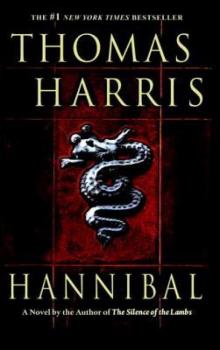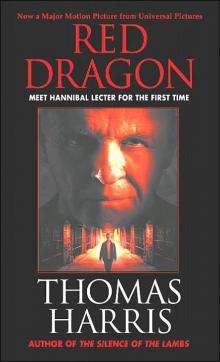- Home
- Thomas Harris
Black Sunday Page 21
Black Sunday Read online
Page 21
“If you tell me, you will not be harmed. If you don‘t, I will leave you worse than dead. I’ll leave you blind, dumb, and crippled. Do I have to hurt you now to demonstrate that I’m serious? I don’t think so. I’ll remove this sock from your mouth now. If you scream, I’ll give you something to scream about, do you understand me?”
Sapp nodded. He spat out lint. “Who the hell are you?”
“That doesn’t concern you. Tell me about the plastic.”
“I don’t know anything about it. You got nothing on me.”
“Don’t think in legalistic terms, Mr. Sapp. You are not protected from me by the law. The people you worked for are not mob-connected, by the way. You don’t have to protect them on that account.”
Sapp said nothing.
“The FBI is looking for you on a smuggling charge. Soon they will add mass murder to the list. That’s a lot of plastic, Sapp. It will kill a lot of people unless you tell me where it is. Look at me when I’m talking to you.”
“Kiss my ass.”
Kabakov rose and jammed the sock back in Sapp’s mouth. He grabbed Sapp by the hair and forced his head back against the wooden bulkhead. The tip of the icepick rested lightly in the corner of Sapp’s rolling eye. A growl rumbled from Kabakov’s chest as he drew back the icepick and struck, pinning Sapp’s ear to the bulkhead. The color had gone from Sapp’s face and there was a foul odor in the cabin.
“You really must look at me when I’m talking to you,” Kabakov said. “Are you ready to cooperate? Blink for yes. Die for no.”
Sapp blinked and Kabakov removed the sock.
“I didn’t go. I didn’t know it was plastic.”
Kabakov believed this was probably true. Sapp was shorter than the man described by the Leticia’s first mate. “But your boat went.”
“Yes. I don’t know who took it out. No! Honestly, I don’t know. Look, it’s my business not to know. I didn’t want to know.”
“How were you contacted?”
“A man called me the last week in October. He wanted the boat ready, standing by, during the week of November eighth. He didn’t say who he was and I didn’t ask.” Sapp grimaced with pain. “He wanted to know a few things about the boat, not much. Hours on the engines, whether it had any new electronics.”
“Any new electronics?”
“Yeah, I told him the loran was out—for God’s sake take this thing out of my ear.”
“All right. You’ll get it through the other one if I catch you in a lie. This man that called, he already knew the boat?”
“Ouch!” Sapp turned his head from side to side and cut his eyes far over, as though he could see his ear. “I guess he knew the boat, he sounded like it. It was worth a thousand to him for it to be available, like a retainer. I got the thousand in the mail at Sweeney’s in Asbury Park two days later.”
“Do you have the envelope?”
“No, it was a plain envelope, New York City postmark.”
“He called you again.”
“Yeah, about November tenth. He wanted the boat for the twelfth, a Tuesday. The money was delivered to Sweeney’s that night.”
“How much?”
“Two thousand for the boat, sixty-five thousand deposit. All cash.”
“How was it delivered?”
“A cab brought it in a picnic basket. Food was on top of it. A few minutes later the phone rang again. It was the guy. I told him where to get the boat.”
“You never saw him pick it up or return it?”
“No.” Sapp described the boathouse in Toms River.
Kabakov had the photo of Fasil and the composite of the woman sealed in a rubber glove in his bag. He took them out. Sapp shook his head at both pictures.
“If you still think I went out with the boat, I’ve got an alibi for that day. A dentist in Asbury Park fixed my teeth. I have a receipt.”
“I expect you have,” Kabakov said. “How long have you owned the boat?”
“A long time. Eight years.”
“Any previous owners?”
“I had it built.”
“How did you return the deposit?”
“I left it in the same basket in the trunk of my car by a supermarket and put the trunk key under the floor mat. Somebody picked it up.”
The New Jersey coastal chart Kabakov had found in Sapp’s chart bin had the course to the rendezvous marked with a neat black line, departure time and running time checks jotted beside it. The bearings for two radio direction finder fixes were penciled in. Three bearings for each fix.
Kabakov held the chart by the edges, under the lantern where Sapp could see it. “Did you mark this chart?”
“No. I didn’t know it was on the boat or I would have gotten rid of it.”
Kabakov took another chart from the bin, a Florida chart. “Did you plot the course on this one?”
“Yes.”
He compared the two charts. Sapp’s handwriting was different. He had used only two bearings for an RDF fix. Sapp’s times were written in Eastern Standard. Time for the rendezvous with the Leticia, jotted on the New Jersey chart, was 2115. This puzzled Kabakov. He knew the Coast Guard cutter had spotted the speedboat close to the freighter at 1700 Eastern Standard. The boat must have been there for some minutes, loading the plastic, so the rendezvous was about 1615 or 1630. Yet it was marked on the chart for five hours later. Why? The departure time from Toms River and the running time checks were also marked about five hours later than they must have occurred. It didn’t make sense. And then it did make sense—the man Kabakov was seeking had not used Eastern Standard time, he had used Greenwich Mean Time—Zulu time—Pilot time!
“What fliers do you know?” Kabakov demanded. “Professional pilots.”
“I don’t know any professional pilots I can think of,” Sapp said.
“Think hard.”
“Maybe a guy in Jamaica with a commercial license. But he’s been in the jug down there ever since the feds vacuumed his luggage compartment. He’s the only professional pilot I know. I’m sure of it.”
“You know no pilots. You don’t know who hired the boat. You know very little, Mr. Sapp.”
“I don’t. I can’t think of any pilots. Look, you can bust me up. You probably will, but I still won’t know.”
Kabakov considered torturing Sapp. The idea was sickening to him, but he would do it if he thought the results would be worth it. No. Sapp was not a principal in the plot. Threatened with prosecution, fearful that he might be an accessory to a major atrocity involving the explosives, he would try to cooperate. He would try to recall any small detail that would identify the man who hired his boat. Better not to hurt him badly now.
The next step should be an intensive interrogation of Sapp about his activities and associates and a thorough lab analysis of the chart. The FBI was better equipped to do these things. Kabakov had come a long way for very little.
He called Corley from a telephone booth on the pier.
Sapp had not consciously lied to Kabakov, but he was mistaken in saying that he knew no professional pilots. It was an understandable memory lapse—it had been years since he had last seen Michael Lander or thought about the frightening, infuriating day of their first meeting.
Sapp had been on his seasonal migration northward when a floating timber mangled both his propellers off Manasquan, New Jersey, forcing him to stop. Sapp was strong and capable, but he could not change a jammed and twisted prop in open water with a sea running. The boat was drifting slowly toward the beach, dragging her anchor before a relentless onshore wind. He could not call the Coast Guard because they would smell the same stench that gagged him as he went below to get his storm anchor—the smell of $5,500 worth of black market alligator hides bought from a Florida poacher and bound for New York. When Sapp returned to the deck, he saw a boat approaching.
Michael Lander, out with his family in a trim little cruiser, threw Sapp a line and towed him to a protected inlet. Sapp, not wanting to be stuck at a marina
with a disabled boat loaded with hot hides, asked Lander to help him. Wearing snorkle masks and flippers, they worked beneath the boat, and their combined strength was enough to pry one of the propellers off its shaft and fit the spare. Sapp could limp home.
“Excuse the smell,” Sapp said uneasily as they sat on the stern, resting. Since Lander had been below in the course of the work, he could not have helped seeing the hides.
“None of my business,” Lander said.
The incident began a casual friendship that ended when Lander returned to Vietnam for his second hitch. Sapp’s friendship with Margaret Lander had continued, however, for some months after that. On the rare occasions when he thought about the Landers, it was the woman Sapp recalled most clearly, not the pilot.
17
ON THE FIRST OF DECEMBER the president informed his chief of staff that he would definitely attend the Super Bowl in New Orleans, whether the Washington Redskins were playing or not.
“Goddamn it,” said Earl Biggs, special agent in charge of the White House Secret Service detail. He said this quietly and alone. He was not surprised—the president had indicated previously that he was likely to go—but Biggs had hoped the trip would be canceled.
I should have known better than to hope, Biggs reflected. The Man’s honeymoon with the nation was over and he had begun to slip a little in the polls, but he would be assured of a standing ovation in the Deep South, with the whole world watching.
Biggs dialed the number of the Secret Service’s Protective Research section. “January twelfth. New Orleans,” he said. “Get on it.”
The Protective Research section has three levels of files. The largest contains every threat that has been made against a president by telephone, mail, or reported utterance in the last forty years. Persons who have made repeated threats or who are considered potentially dangerous are listed in a “live file.”
The live files are reviewed every six months. Changes in address, job status, and international travel are noted. At present, there are 840 names in the live file.
Of these, the 325 considered most serious are also listed in a geographically indexed “trip file.” Before each presidential trip, the persons listed in the area involved are investigated.
With forty-three days of lead time, the clerks in Protective Research and the agents in the field had plenty of time to check out New Orleans.
Lee Harvey Oswald was never listed in the Secret Service trip file. Neither was Michael Lander.
On December 3, three agents from the White House Secret Service detail were dispatched to New Orleans to take charge of security arrangements. Forty days’ lead time and a three-man team have been standard procedure since 1963. On December 7, Jack Renfro, leader of the three-man detail, sent a preliminary report to Earl Biggs at the White House.
Renfro did not like Tulane Stadium. Anytime the president appeared in public, Renfro could feel the exposure crawling on his own skin. The stadium, home of Tulane’s Green Wave, the Sugar Bowl Classic, and the New Orleans Saints, is the largest steel stadium in the world. It is rusty gray and tan and the area beneath the stands is a forest of girders and beams, a nightmare to search. Renfro and the other two Secret Service agents spent two days climbing through the stadium. When Renfro walked out onto the field, every one of the 80,985 seats threatened him. The glassed-in VIP booth high on the west side of the stadium at the end of the press gallery was useless. He knew the president would never consent to use it, even in the case of inclement weather. No one could see the president there. He would use the VIP box, at the front of the west stands on the fifty-yard line. For hours Renfro sat in the box. He placed a member of the New Orleans police department in it for an entire day, while he and the other two agents checked the lines-of-sight from various positions in the stands. He personally inspected the cream of the New Orleans police department‘s Special Events squad—the officers who would be assigned to the stadium.
He tried routes from New Orleans International Airport to the stadium via U.S. 61, state highway 3046, and U.S. 90 and a combination of Interstate 10 and the Claiborne Avenue section of U.S. 90. All routes seemed endless, especially in light of the notorious traffic problem in the stadium area.
The preliminary evaluation Renfro sent to special agent Biggs at the White House said in part:
Suggest we recommend in the strongest terms that the president be helicoptered from New Orleans International Airport to the stadium following this procedure:
1. A motorcade will be ordered to stand by at the airport, but will be used by peripheral members of traveling party.
2. No helipad will be marked at the stadium until the president’s helicopter is airborne from New Orleans International. At that time a portable fabric landing marker will be deployed at the south end of the infield on the track outside the northwest corner of the stadium. (See attached diagram A-1.) The track has no overhead wires and provides a clear landing area in the infield, but has three tall light standards on each side. These standards do not appear on the New Orleans sectional and VFR terminal area chart. Their presence should be emphasized at the pilot’s briefing.
3. From the landing pad to Gate 19 is 100 paces. (Note enclosed photograph A-2.) Have requested removal of the unsightly garbage container indicated beside stadium wall. Suggest agents on the ground at landing point check the bushes at the edge of the stadium at Zero minus one minute.
The landing area can be covered from the rear upper floors of five houses on Audubon Boulevard. They are numbers 49, 55, 65, 71, and 73. Preliminary check indicates they are all occupied by citizens considered zero threat. The roofs and windows should be observed during the arrival, however.
In the event a crowd remains at the ticket windows at Gate 19 when the president arrives, Gate 18 and vendor’s gate 18A could be used, but these are considered less desirable, as they would necessitate a short walk under the stands.
From Gate 19, the president would be exposed to the area under the stands for 75 paces before reaching the sideline at the goal line.
The president will use Box 40, a double-size box at the 50-yard line. (See attached diagram A-3.) Note the railings allow access at front and rear. Also note the rear of the box is elevated 6 inches by a step. Tall agents seated behind the president in Box 40 would give considerable coverage from behind. Secret Service boxes will be numbers 14 and 13 in front of the Presidential Box to the right and left. At least one agent each should be in Boxes 71, 70, 69, and 68, to the rear.
The railing of Box 40 is constructed of iron pipe. The ends are capped. These caps should be removed and the interior of the pipes examined immediately before the president’s arrival.
The box contains one telephone terminal box. I am advising Signal Corps on details. (Memo to Signals attached.) Diagram A-4, stadium overview and seating chart, shows individual agent assignments and areas of responsibility.
Our radio frequency is clear.
Details of egress are subject to modification pending our observation of crowd flow at the Sugar Bowl game December 31.
Jack Renfro was a careful and conscientious man, skilled at his trade. He had learned the stadium by heart. But as he catalogued its dangers, he never once looked up at the sky.
18
LANDER FINISHED THE BOMB TWO days after Christmas. Its sleek skin, midnight blue and bearing the bright insignia of the National Broadcasting System, reflected the harsh garage lights as it lay in its loading cradle. The clamps that would fasten it to the gondola of the blimp hung from the upper rim like open hands, and the electrical connections and backup fuse were taped in neat coils on the top. Inside the skin, the 1,316.7 pounds of plastic explosive rested in two great slabs of precise thickness, curving behind the layers of bristling darts. The detonators were packed separately, ready to be plugged into place.
Lander sat staring at the great bomb. He could see his reflection distorted on its side. He thought that he would like to sit on it now, and plug in the detonators and hold the wir
es like reins, touch them to the battery and ride the mighty fire-bloom into the face of God. Sixteen days to go.
The telephone had been ringing for some time when he answered it. Dahlia was calling from New Orleans.
“It’s finished,” Lander said.
“Michael, you’ve done a beautiful job. It’s a privilege to watch you.”
“Did you get the garage?”
“Yes. It’s near the Galvez Street wharf. Twenty minutes from New Orleans Lakefront Airport. I’ve driven the route twice.”
“You’re sure it’s big enough.”
“It’s big enough. It’s a walled-off section of a warehouse. I’ve bought the padlocks and put them on. Now may I come home to you, Michael?”
“You’re satisfied?”
“I’m satisfied.”
“With the airport, too?”
“Yes. I had no trouble getting in. I can make it in the truck when the time comes.”
“Come home.”
“I’ll see you late tonight.”
She did well, Lander thought as he hung up the telephone. Still, he would have preferred to make the arrangements in New Orleans himself. There had been no time. He still had to fly a National Football Conference playoff game and the Sugar Bowl in New Orleans before the Super Bowl. His time was used up.
The problem of moving the nacelle to New Orleans had worried him, and the solution he found was less than ideal. He had leased a two-and-one-half-ton truck, which now stood in his driveway, and he had engaged two bonded professional truck drivers to take it to New Orleans. They would leave tomorrow. The back of the truck would be sealed, and even if the drivers did see the device they would not know what it was.
Putting the bomb in the hands of strangers made Lander uneasy anyway. But there was no help for it. Fasil and Dahlia could not drive the truck. Lander was certain that the authorities had broadcast their descriptions in the Northeast. Fasil’s forged international driving license was sure to attract attention if he were stopped by the police. Dahlia would be very conspicuous at the wheel of a big truck. She would be ogled at every step. Besides, Lander wanted Dahlia to be with him.

 The Silence of the Lambs
The Silence of the Lambs Red Dragon
Red Dragon Hannibal
Hannibal Black Sunday
Black Sunday Cari Mora
Cari Mora Hannibal Rising
Hannibal Rising Red Dragon hl-1
Red Dragon hl-1 The Silence of the Lambs (Hannibal Lecter)
The Silence of the Lambs (Hannibal Lecter)